Siân Robertson leads “Don’t Be Afraid of the Internet! Basic Website Design for Artists,” an online workshop via the Provincetown Art Association and Museum, on Mondays beginning April 5th, from 1 to 3 p.m. Registration is $150 at paam.org. Kath Macaulay teaches pocket sketching on Mondays and Thursdays beginning April 5th, 2:30 to 4 p.m. Registration is $175.
Provincetown Art Association and Museum
DIY Website
Siân Robertson leads “Don’t Be Afraid of the Internet! Basic Website Design for Artists,” an online workshop via the Provincetown Art Association and Museum, on Mondays beginning April 5th, from 1 to 3 p.m. Registration is $150 at paam.org. Kath Macaulay teaches pocket sketching on Mondays and Thursdays beginning April 5th, 2:30 to 4 p.m. Registration is $175.
Blank Canvas
Pete Hocking is teaching “Back to Basics: First Time, Tuning Up, or Returning to Painting,” an online workshop from the Provincetown Art Association and Museum, on Saturdays beginning March 27th, from 11 a.m. to 5 p.m. According to the description, “This workshop is designed for people who want to paint, but feel like they’ve never been invited to the party.” Registration is $300 at paam.org.
A Very Artistic Treasure Hunt
ArtTrek is an “art-fueled treasure hunt” from the Provincetown Art Association and Museum. In response to Covid, PAAM “created this new art project in hopes of giving people an outdoor activity that connects them with art, the museum, and Provincetown,” according to the announcement.
The art association has hidden 21 glass bottles on public property throughout town. Each contains instructions on how to claim prizes, including works of art, memberships, and gift certificates. The ArtTrek runs from March 1st through December 15th or earlier, if all the bottles are found. If you do find one, carefully remove the cork — don’t break it! Take a selfie and tag PAAM on Instagram or Facebook. Then, pick up your prize at 460 Commercial St.
State of the Art
Megan Hinton is hosting an online lecture series on contemporary painting via the Provincetown Art Association and Museum on Wednesdays beginning March 10th, from 10 to 11:30 a.m. Each of the five sessions will explore a different decade from 1970 to 2020, with an emphasis on multicultural, LGBTQ, and women artists. “This is an opportunity to immerse oneself beyond the local scope of Cape Cod art,” says the course description. Registration is $50 at paam.org.
For Art’s Sake
Elizabeth Bradfield is teaching “Art Inspiring Art: An Ekphrastic Poetry Workshop” via the Provincetown Art Association and Museum on Thursdays beginning March 4th, from 3 to 5 p.m. “From Homer to Natasha Trethewey to Rilke to Linda Bierds, poets have used the work of visual artists as a springboard for their own concerns and creations,” writes Bradfield in the course description. Registration for this online workshop is $250 at paam.org.
Dip Your Toes
Lisa Goren is teaching a virtual workshop on wet-on-wet watercolor via the Provincetown Art Association and Museum on Fridays beginning February 26th, from 1 to 3 p.m. “The classes focus on working with water, learning how to mix colors, understanding paper, and using the strengths (and weaknesses) of the medium to your advantage,” according to the course description. Registration is $125 at paam.org. Also via PAAM, Pete Hocking is teaching an online workshop on the “Autobiographical Figure” on Saturdays beginning February 27th, from 11 a.m. to 5 p.m. It will use mirrors and reference photographs to “explore, interrogate, and mythologize personal history.” Registration is $300.
PAAM Exhibit Goes ‘Large’
An exhibition of large works from the permanent collection at the Provincetown Art Association and Museum is on display at 460 Commercial St. through May 2.
PAAM’s collection comprises nearly 4,000 works by over 700 artists. Works in the show range in size from Blanche Lazzell’s 36-by-36-inch Painting No. 12 to George McNeil’s 78-by-72-inch Beach Scene. Other highlights are Archipelago, a mixed media on canvas by Sarah Lutz; Duo, a charcoal on paper by Selina Trieff; and Dream House, an oil on canvas by Jay Milder.
Show of New Gifts to the PAAM Collection
An exhibition of recent gifts to the permanent collection at the Provincetown Art Association and Museum is on display at 460 Commercial St. through March 28.
“As an actively collecting museum, PAAM receives on average nearly 100 new works each year,” writes CEO Christine McCarthy in the announcement. The museum owns nearly 4,000 works in total. Highlights of the exhibition are Marvin Hagler, Provincetown, a photograph by Michael J. Brennan; Pilgrim Lake, an oil on canvas by Janice Biala; Portrait of Edwin Dickinson, by Paul Hollister; a self-portrait by Eben Given Jr.; and an untitled charcoal on paper by Jack Tworkov.
Mishmash
Create a papier-mâché masterpiece in an online course with Heather Blume, via the Provincetown Art Association and Museum, on two consecutive Saturdays beginning February 13th, from 10 a.m. to noon. “In this class we will cover, no pun intended, creating both flat and sculpted artworks,” according to the course description. All ages are welcome. Registration is $150 at paam.org.
Figure It Out
Laura Shabott and Alana Barrett are teaching an online class, via the Provincetown Art Association and Museum, on Hans Hofmann’s push-pull theory. It will take place Sunday, February 7th, from 10 a.m. to 2 p.m. “With the figure as our muse and prompt, we will explore how color and shape respond to the figure through the lens of modernist principles,” says the course description. Registration is $150 at paam.org.
MUSEUM TOUR
Napi Van Dereck Exhibit Sequel Opens at PAAM
Works by noteworthy women artists are featured
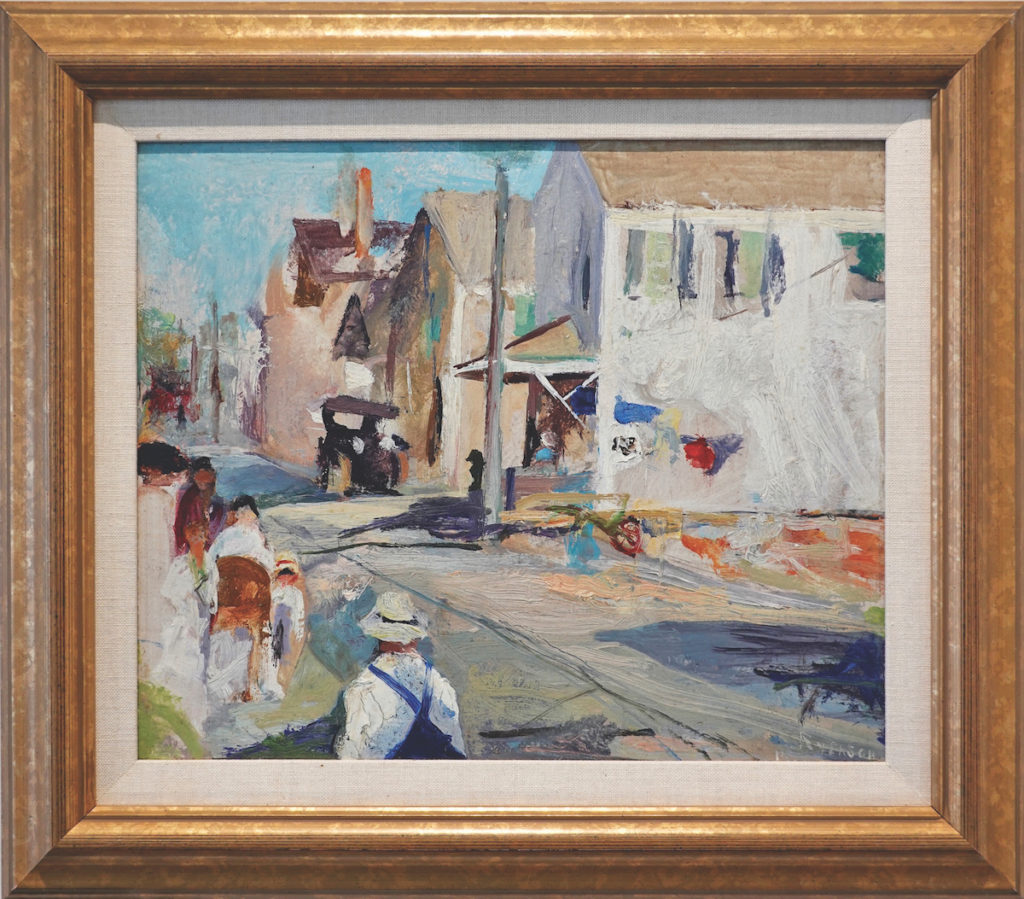
An exhibition of artworks from the collection of Napi and Helen Van Dereck opened last Friday at the Provincetown Art Association and Museum. The first installment of this show took place in March of last year, a few months after Napi, the beloved restaurateur and art collector, died. Because of the Covid lockdown, the exhibit was viewable only online before opening to the public for the summer.
This second installment (“Part II”) proves that Napi’s extensive collection of classic Provincetown art, which is on extended loan to the museum, is far from exhausted. It’s full of gems by Ross Moffett, George Yater, and others. But most notable is the representation of women artists.
Out of 32 artworks, 10 are by women. That’s not equal representation, but it’s pretty good, especially considering that much of the work dates from the early 20th century. The exhibition last March was even better in this regard — about half of the works were by women artists.
In the introduction to last March’s show, curator and PAAM CEO Christine McCarthy wrote that Napi was a “champion of women artists.” She also conferred with James Bakker, a local art dealer, historian, and PAAM board member, who is a strong advocate for the women artists who have been largely absent from the Provincetown art colony historical narrative.
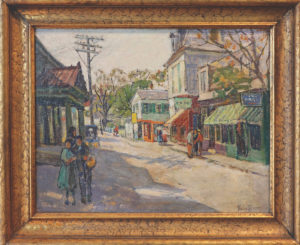
One small disappointment, however, is that the extraordinary Blanche Lazzell, though mentioned in the introduction, is not included in Part II.
Margery Austen Ryerson’s Commercial Street, Provincetown, dated 1911, is small and easy to miss but a highlight of the exhibit. Ryerson lived to be 102 — she even witnessed her centennial show, according to a catalogue by Avis Berman — but she was only in her mid 20s when she painted Commercial Street.
She studied with Charles Webster Hawthorne in Provincetown in the summers from 1911 to 1920. She was, clearly, a good student — Hawthorne’s influence can be seen in the way that the headlights of a vintage automobile are suggested with two swirls of white. A gentleman’s overalls are rendered with two crisscrossed strokes of blue. Ryerson used a lot of paint — evidenced in the way the painting has caked and cracked — and loose, fluid brushstrokes.
Ryerson’s notebooks were the source for the majority of the art text Hawthorne on Painting, which she edited. In New York City, she studied with Robert Henri — she compiled his book The Art Spirit — and painted children in settlement houses.
Though the subjects and vantage point of Ryerson’s Commercial Street and Street Scene, Provincetown, by Pauline Palmer, are nearly identical, the two paintings couldn’t be more different. Palmer was a Chicago-based artist who studied with William Merritt Chase, then came to Provincetown to study with Hawthorne, one of Chase’s students.
She won numerous awards throughout her life. “Palmer was often one of the few women to serve on exhibition juries that were still largely dominated by male artists,” writes Ruth L. Bohan as part of the Illinois Historical Art Project.
Despite the growing dominance of modernism, Palmer maintained a conservative style as long as she painted. In Street Scene, she outlines buildings, trees, and figures in black. One can almost make out the colorful signs outside the striped storefront awnings.
Another interesting backstory from the exhibit is that of Alice Y. Hirsh, who painted Untitled (Pier at Low Tide), a rather unassuming oil on panel from 1916. The tall pilings are reflected in the pale blue water, as are the two people sitting on the pier. The impressionist influence is manifest.
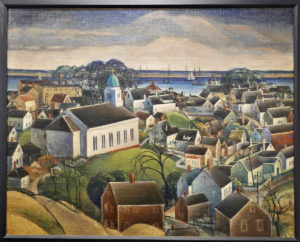
Hirsch studied at the Art Students League of New York. By 1917, she had established her own studio at 51 West 10th St., in Greenwich Village. “She directly marketed her own works from this location and through shows,” which was “quite uncommon,” according to the exhibition label.
The focal points of the Napi show, however, are four paintings from the 1920s by Nancy Maybin Ferguson: East End View, West End Looking Southwest from St. Peter’s, and two untitled oils of the Wren Tower and North Truro Center.
Ferguson, a member of the “Philadelphia Ten,” a group of women artists who showed together, also studied with Hawthorne and Chase.
These bird’s-eye views, slightly oblique, are reminiscent of old map prints, such as Jacopo de’ Barbari’s View of Venice. Indeed, there is something Italian about West End Looking Southwest — St. Peter the Apostle Church, captured here before it was rebuilt after a 2005 fire, could almost be a Renaissance chiesa.
Classic Provincetown
The event: “The Napi and Helen Van Dereck Collection: Part II”
The time: Hourlong time slots from Thursday through Sunday, noon to 5 p.m. Space is limited; reservations at paam.org/tickets
The place: Provincetown Art Association and Museum, 460 Commercial St.
The cost: Museum admission is $12.50; members free
Male Gays
Pete Hocking is teaching “Queer Men Painting Figures,” an online workshop via the Provincetown Art Association and Museum, on Saturdays beginning January 30th, from 11 a.m. to 5 p.m. Participants will look at artworks by contemporary queer male artists, and make art themselves, working from a mirror, photographs, or other source material. All gender identities are welcome. Registration is $300 at paam.org.
Male Gays
Pete Hocking is teaching “Queer Men Painting Figures,” an online workshop via the Provincetown Art Association and Museum, on Saturdays beginning January 30th, from 11 a.m. to 5 p.m. Participants will look at artworks by contemporary queer male artists, and make art themselves, working from a mirror, photographs, or other source material. All gender identities are welcome. Registration is $300 at paam.org.
PHOTOGRAPHY
Lew Schwartz Turns His Eye to the Outer Cape
In his scope of vision, every picture tells a story
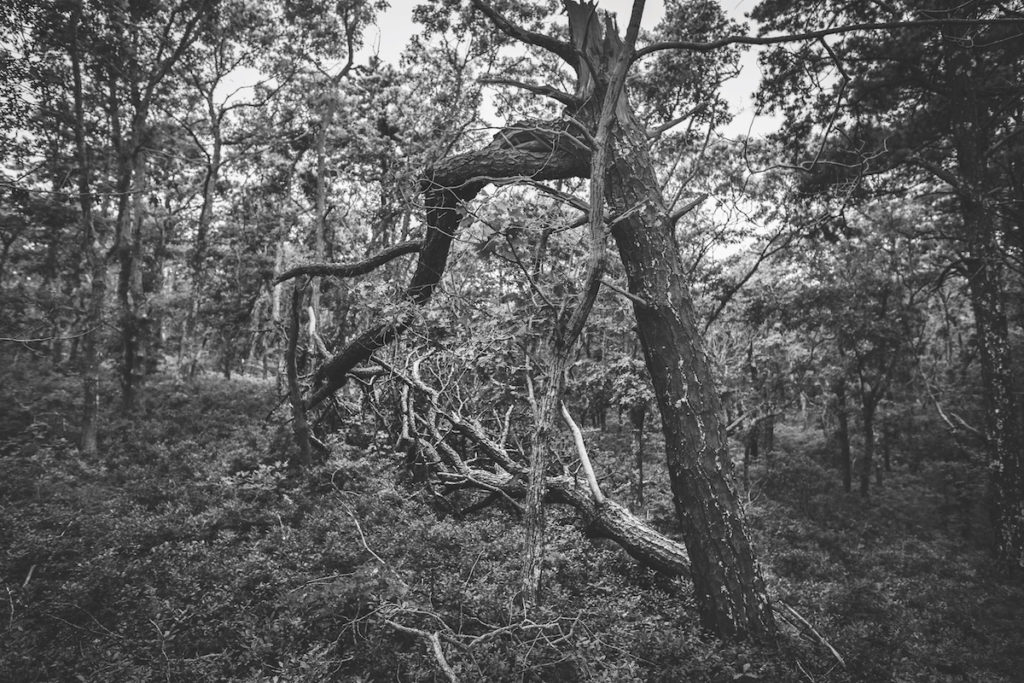
“Clear mind, tabula rasa, the four corners of the frame, calm breath,” photographer Lew Schwartz says as he prepares to shoot. “Someone on the street brushes away a mosquito, waves to a friend, or gives you the finger. People avoid collisions, come together, disappear. You can also see such gestures in the impossibly dense undergrowth of invasive brush or the way a pine tree grows toward the light for 20 to 30 years, then changes direction. They’re revealed by the lens and frozen in time by the shutter. It doesn’t matter whether it existed for one millionth of a second or a century.”
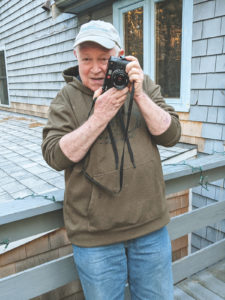
A philosopher in frames, Schwartz photographed the bustling streets of New York City for decades before retiring to Wellfleet with his wife, Chris, five years ago. Now, he focuses on the quiet disintegration of leaves and trees in the woods of the Outer Cape. He often posts work on Facebook, and a shot of his made it into the Members’ Juried Show at the Provincetown Art Association and Museum.
Born in Boston, Schwartz grew up on Long Island, N.Y. Fascinated by images at an early age, he became his family’s photographer when he was eight years old. His natural talent caught the eye of someone who worked at the hospital where his father was a radiologist. “That gentleman did all the publicity photos for the hospital,” Schwartz says. “He took me under his wing when I was about 10 and gave me a very thorough and unusually intense introduction to photography.”
In the 1960s, Schwartz went to N.Y.U. His student days introduced him, he says, to “an entire other world, accessible with the exact same equipment I was already using.” He was studying 14th-century English literature, yet he found himself spending most of his time in museums and photographing student protests on the streets.
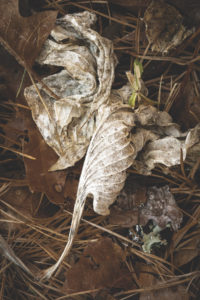 “New York City in the ’60s was probably the most intellectually stimulating place you could be on the planet,” Schwartz says. “Those years had a permanent impact on the way I view life. I was volunteering at various photographic institutions in the city, such as the International Center of Photography. I knew Cornell Capa and his people, who founded the ‘concerned photographer movement.’ The emphasis was on socially relevant photography. At the same time, the Museum of Modern Art hosted the ‘New Documents’ exhibit, showing that documentary-style photography could be extremely expressive. The street work of the photographers in that show — Diane Arbus, Garry Winogrand, Lee Friedlander — was a total revelation.”
“New York City in the ’60s was probably the most intellectually stimulating place you could be on the planet,” Schwartz says. “Those years had a permanent impact on the way I view life. I was volunteering at various photographic institutions in the city, such as the International Center of Photography. I knew Cornell Capa and his people, who founded the ‘concerned photographer movement.’ The emphasis was on socially relevant photography. At the same time, the Museum of Modern Art hosted the ‘New Documents’ exhibit, showing that documentary-style photography could be extremely expressive. The street work of the photographers in that show — Diane Arbus, Garry Winogrand, Lee Friedlander — was a total revelation.”
Schwartz learned that even the most minor detail can contribute something to a photograph. “Arbus, Winogrand, and Friedlander compose images rather than photograph things. And their work is self-reflective. You come away knowing more about yourself than you do about the people in the photos.”
After graduating, Schwartz took a job teaching English in the New York public schools to avoid the Vietnam War draft, and moved to Brooklyn, where he married and raised a family. Though he worked in the schools until his retirement, Schwartz’s true passion remained photography. “I always got up very early so that I could have my afternoons available for photography,” Schwartz says. “I was on the streets at 2 p.m., literally every day, 365 days a year.”
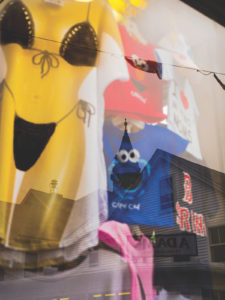
Walking a city “dense with people,” Schwartz says, “you can’t have an agenda. You can’t look for good pictures. You respond to anything that grabs your eye, that strikes you as different: somebody carrying too many parcels or wearing too much makeup.”
Schwartz has learned to find ways of blending in so he can capture candid moments. “Once, during the annual Mermaid Parade on Coney Island, I joined a group of stripteasers,” he says with a chuckle. “I didn’t strip myself, but I was able to march with them and take photographs of the crowd.” Likewise, his strategy during parades in Provincetown is to “hop onto a vehicle and photograph people from there. In New York, I’d be arrested!”
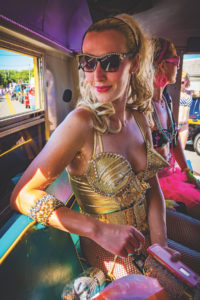
During a recent Carnival parade, Schwartz snapped a picture of a young woman in a golden top à la Madonna. “She was so self-absorbed, sitting next to this old guy with a camera, that she wasn’t even aware that I was there,” he says.
Schwartz uses a 35-mm camera and leaves the film in the freezer for some time before developing it. “If you look at your images right away, you tend to answer the question: did I get what I wanted? And that’s really no good,” he says. He’s always “unpeeling the depth of a single image.” Recently, he’s been following the decay of hosta leaves and the shifting forms of falling pines, going back to the same leaf or branch for weeks.
“Early on, it became apparent to me that the fall of a large tree didn’t signal its death, but rather the beginning of a new phase,” Schwartz says. “This pivotal time between seasonal growth is really just part of a process. As leaves decay, they become the residence of many tiny insects, fungi, and bacteria. Similarly, a fallen tree is teeming with life. Its significance comes from being part of a much larger narrative.”
